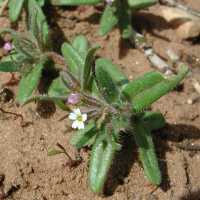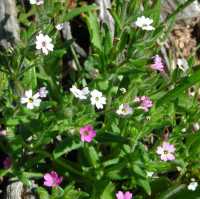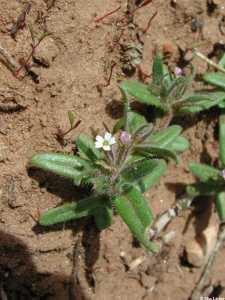Duration: Annual
Nativity: Native
Lifeform: Forb/Herb
General: Annual with 1-3 erect stems, 3-15 cm tall, often branched below, the lower stems ascending or spreading.
Leaves: Linear to elliptic or narrowly oblanceolate, pubescent and glandular, 1-2 cm long, 2-5 mm wide.
Flowers: Terminal inflorescence of 1-2 flowers, subsessile to pedicelled at tips of terminal branches, sometimes axillary, pedicels glandular; calyx 3-8 mm long; corolla white to bluish lavender, the throat sometimes yellow tinged, the tube 4-8 mm long, the lobes 1-2 mm long, obtuse to retuse; stamens inserted on the upper tube and throat; stigmas located among the lower stamens.
Fruits: Ovoid to ellipsoid capsule splits open when mature, leaving a recognizable tan, star-shaped feature.
Ecology: Found on open, sandy to gravelly sites from 1000-8,000 ft (305-2438 m); flowers March-August.
Notes: Very small spring annual that is very abundant in some years.
Ethnobotany: Applied to wounds and bruises, sores on body, as a mouthwash for sores, and on bruised or sore legs.
Etymology: Microsteris comes from Greek mikros, small and aster, start, while gracilis means slender or graceful.
Synonyms: There is uncertainty about this subspecies.
Editor: SBuckley, 2010
PLANT: Annual with 1-3 erect stems, 3-15 cm tall, often branched below, the lower stems ascending or spreading.
LEAVES: linear to elliptic or narrowly oblanceolate, pubescent and glandular, 1-2(-4) cm long, 2-5 mm wide.
INFLORESCENCE: flowers 1-2, subsessile to pedicelled at tips of terminal branches, sometimes axillary; pedicels glandular.
FLOWERS: calyx 3-8 mm long; corolla white to bluish lavender, the throat sometimes yellow tinged, the tube 4-8 mm long, the lobes 1-2 mm long, obtuse to retuse; stamens inserted on the upper tube and throat; stigmas located among the lower stamens.
SEEDS: gelatinous when wet.
NOTES: Open, sandy to gravelly sites; Apache, Cochise, Coconino, Gila, Graham, Maricopa, Mohave, Pima, Pinal, Santa Cruz, Yavapai cos.; 300-2450 m (1000-8000 ft); Mar-Aug; w N. Amer., S. Amer.
REFERENCES: Dieter H. Wilken and J. Mark Porter, 2005, Vascular Plants of Arizona: Polemoniaceae. CANOTIA 1: 1-37.







